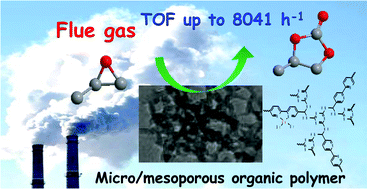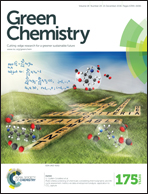Hierarchical mesoporous organic polymer with an intercalated metal complex for the efficient synthesis of cyclic carbonates from flue gas†
Abstract
CO2 capture and utilization is one of the most attractive and challenging topics of the twenty-first century. The direct conversion of CO2 using flue gas as a feedstock is an energy saving process, but it has been rarely reported. Herein, we report an efficient CO2 cycloaddition reaction using diluted gas (20% CO2 and 80% N2, simulating flue gas) as a feedstock, catalyzed by a 2,2′-bipyridine zinc(II) based hierarchical meso/microporous polymer, Bp-Zn@MA. Bp-Zn@MA, constructed via a template-free polycondensation reaction without using any catalyst, can efficiently catalyze the cycloaddition of propylene oxide with a TOF of up to 1580 h−1 (100 °C) and 8041 h−1 (150 °C), using diluted gas and pure CO2, respectively. This is among the best performing solid catalysts ever reported for the CO2 cycloaddition reaction. The high catalytic activity of the polymer, especially when diluted CO2 was employed, can be mainly attributed to its hierarchical meso/microporous structure, which contains mesopores for facilitating the diffusion of reactants and micropores for CO2 enrichment. The construction of this hierarchical structured porous material provides an efficient approach for realizing CO2 conversion using flue gas as a feedstock.


 Please wait while we load your content...
Please wait while we load your content...